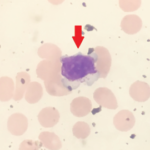Romosozumab Reduces Risk of New Vertebral Fractures
A Phase 3 placebo-controlled fracture study in postmenopausal women with osteoporosis (FRAME) has shown that romosozumab reduces new vertebral fracture risk.3 Romosozumab is an investigational, bone-forming monoclonal antibody that inhibits the protein, sclerostin. Romosozumab has dual bone effects, increasing bone formation and decreasing bone resorption.4
Co-primary endpoints of reduced new vertebral fracture incidence through Month 12 and Month 24 were attained with monthly subcutaneous injections of romosozumab. At Month 12, a statistically significant 73% reduction in the relative risk of a vertebral fracture was noted. Through Month 24, a statistically significant 75% reduction in the relative risk of new vertebral fractures was noted for romosozumab followed by denosumab vs. placebo followed by denosumab.
The secondary endpoint of reducing the incidence of clinical fractures (a composite of non-vertebral and vertebral fractures) in postmenopausal women with osteoporosis through Month 12 was also attained. However, the secondary endpoint of reducing the incidence of non-vertebral fractures through Month 24 was not met.
Adverse reactions included arthralgia, back pain and nasopharyngitis. Injection site reactions occurred in 5.2% of romosozumab-treated patients vs. 3% of placebo-treated patients during the 12-month period. Most injection site reactions were mild in severity.
Michele B. Kaufman, PharmD, CGP, RPh, is a freelance medical writer based in New York City and a pharmacist at New York Presbyterian Lower Manhattan Hospital.
References
- American College of Rheumatology. News release: American College of Rheumatology encourages safe adoption of biosimilars during FDA public hearing on CT-P13, a proposed biosimilar for infliximab (remicade). 2016 Feb 10.
- Pfizer Inc. News release: Pfizer announces FDA approval of Xeljanz XR (tofacitinib citrate) extended-release tablets, the first and only once-daily oral JAK inhibitor treatment for rheumatoid arthritis. 2016 Feb 24.
- Amgen Inc. News release: Amgen and UCB announce positive top-line results from the phase 3 study of romosozumab in postmenopausal women with osteoporosis. 2016 Feb 21.
- McKee S. Amgen, UCB osteoporosis drug hits PhIII goals. PharmaTimes Digital. 2016 Feb 22.


